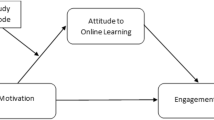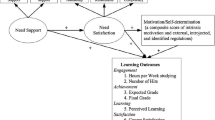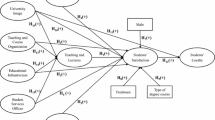Abstract
This paper argues that student orientation (SO) is a high order construct that should be measured formatively rather than reflectively. Using a discovery-oriented approach, conducted by supplementing educational and marketing literatures with in depth interviews from 23 academic staff in seven different universities, the authors identified three second-order formative constructs and one first-order reflective construct to measure the concept of SO. The study then developed a self-administrated survey to validate the four identified constructs that form SO. Through using rigours statistical analysis, the study confirms that the measurement instrument for SO is the 53-item which can be validly and reliably measured using the nine multi-item components of: Measuring and Adapting Teaching Practices, Promoting Best Teaching Practices, Assessment and Feedback, Adopting Outside-In-Approach, Student Engagement, Employer Engagement Initiatives, Intrafunctional Coordination, Interfunctional Coordination and Effective Personal Tutoring System. The effect of SO on student satisfaction and university reputation was also hypothesised and tested using a structural equation modelling (SmartPLS 2.0).

Similar content being viewed by others
Notes
The original number of first-order indicators was eight, however, when performing factorial analysis, a new factor emerged called “measuring and adopting teaching practices”.
References
Aaker, D., Kumar, V., & Day, S. (1995). Marketing research. New York: Wiley.
Accounting Education Change Commission (AECC). (1993). Evaluating and rewarding effective teaching: Issues statement no. 5. Torrence, CA: AECC. Retrieved from http://aaahq.org/aecc/PositionsandIssues/issues5.htm.
Agasisti, T., & Catalano, G. (2006). Governance models of university system–towards quasimarkets? tendencies and perspectives: A European comparison. Journal of Higher Education Policy and Management, 28(3), 245–262.
Argenti, P. (2000). Branding b-schools: Reputation management for MBA programs. Corporate Reputation Review, 3(2), 171–178.
Assad, Y. (2011). An investigation into export market orientation in UK universities from the international marketing managers perspective: A mixed-method approach. PhD submitted to University of Brunel. Retrieved from http://bura.brunel.ac.uk/bitstream/2438/5838/1/FulltextThesis.pdf.
Baert, P., & Shipman, A. (2005). University under siege? Trust and accountability in the contemporary academy. European Societies, 7(1), 157–185.
Bagozzi, R., Yi, Y., & Phillips, L. (1991). Assessing construct validity in organizational research. Administrative Science Quarterly, 36(3), 421–458.
Barone, S., & Franco, E. (2007). Design of a university course quality by Teaching Experiments and Student Feedback (TESF).
Bartlett, M. S. (1954). A note on the multiplying factors for various chi square approximations. Journal of Royal Statistical Society, 16(Series B), 296–298.
Bennett, R., & Ali-Choudhury, R. (2009). Second gift behaviour of first time donors to charity: An empirical study. International Journal of Nonprofit and Voluntary Sector Marketing, 14, 161–180.
BIS, Department for Business, Innovation and Skills. (2011). Student at the heart of the system. White Paper. http://bis.gov.uk/assets/biscore/highereducation/docs/h/11-944-higher-education-students-at-heart-of-system.pdf.
Bitner, M. (1995). Building service relationships: It’s all about promises. Journal of the Academy of Marketing Science, 23(4), 246–251.
Bolden, R., Hirsh, W., Connor, H., Petrov, G., & Duquemin, A. (2010). Strategies for effective HE-employer engagement: A south west higher level skills pathfinder research report. London: The Council for Industry and Higher Education. http://www.employment-studies.co.uk/pubs/report.php?id=he_ee_0210.
Brady, E., Brace-Govan, J., Brennan, L., & Conduit, J. (2011). Market orientation and marketing in nonprofit organizations. Indications for fundraising from Victoria. International Journal of Nonprofit and Voluntary Sector Marketing, 16(1), 84–98.
Cameron, S., & Price, D. (2009). Business research methods—A practical approach. London: Chartered Institute of Personnel and Development.
Chaharbaghi, K. (2007). Provision of public services in an age of managerialism: looking better but feeling worse. Equal Opportunities International, 26(4), 319–330.
Chonko, B., Tanner, F., & Davis, R. (2002). What are they thinking? Students’ expectations and self-assessments. Journal of Education for Business, 77(5), 271–281.
Church, A., & Waclawski, J. (2001). Designing and using organizational surveys: Seven step process. San Francisco: Jossey-Bass.
Churchill, G. (1979). A paradigm for developing better measures of marketing constructs. Journal of Marketing Research, 19, 491–504.
Coates, H. (2005). The value of student engagement for higher education quality assurance. Quality in Higher Education, 11(1), 25–36.
Corley, G., & Gioia, D. (2004). Identity ambiguity and change in the wake of a corporate spin-off. Administrative Science Quarterly, 49, 173–208.
Coyne, I. (1997). Sampling in qualitative research. Purposeful and theoretical sampling: merging or clear boundaries? Journal of Advanced Nursing, 26(3), 623–630.
Day, S. (1994). The capabilities of market-driven organisations. Journal of Marketing, 58(4), 37–61.
Denzin, K., & Lincoln, Y. (2011). Handbook of qualitative research. Thousand Oaks: Sage.
Dey, I. (2004). Grounded theory. In C. Seale, G. Gobo, J. F. Gubrium, & D. Silverman (Eds.), Qualitative research practice. London: Sage.
Driscoll, C., & Wicks, D. (1998). The customer-driven approach in business education: A possible danger? Journal of Education for Business, September/October, 58–61.
Eimers, M., Braxton, J., & Bayer, A. (2001). Normative support for improving undergraduate education in teaching-oriented colleges. Research in Higher Education, 42(5), 569–592.
Flavian, C., & Lozano, J. (2006). Organisational antecedents of market orientation in the public university system. International Journal of Public Sector, 19(5), 447–467.
Fornell, C., & Larcker, D. (1981). Evaluating structural equation models with unobservable variables and measurement error. Journal of Marketing Research, 18(1), 39–50.
Franz, S. (1998). Whatever you do, don’t treat your students like customers! Journal of Management Education, 22, 63–69.
Fredericks, E. (2011). An assessment of marketing department student portfolios. American Marketing Association/Summer.
Gainer, B., & Padanyi, P. (2002). Applying the marketing concept to cultural organizations: an empirical study of the relationship between market orientation and performance. Journal of Nonprofit and Voluntary Sector Marketing, 7(2), 182–193.
Garson, G. D. (2008). Statnotes: Topics in multivariate analysis. Retrieved from http://www2.chass.ncsu.edu/garson/pa765/structur.htm.
Garvin, A. (1987). Competing on the eight dimensions of quality. Harvard Business Review, November–December, 101–109.
Glaser, B. (1978). Theoretical sensitivity. Mill Valley, CA: Sociology Press.
Grant, A. (2006). Personal tutoring: A system in crisis? In L. Thomas & P. Hixenbaugh (Eds.), Personal tutoring in higher education. Stoke on Trent: Trentham Books.
Gray, J., Fam, S., & Llanes, A. (2003). Cross cultural values and the positioning of international education brands. Journal of Product and Brand Management, 12(2), 108–119.
Gray, B., Matear, M., Christo, B., & Phil, M. (1998). Developing a better measure of market orientation. European Journal of Marketing, 32(9/10), 884–904.
Gross, M., & Hogler, R. (2005). What the shadow knows: Exploring the hidden dimensions of the consumer metaphor in management education. Journal of Management Education, 29(1), 3–16.
Hammond, L., & Webster, R. (2011). Market focus in AACSB member schools: An empirical examination of market orientation balance and business school performance. Academy of Marketing Studies Journal, 15(1), 11–22.
Hart, S., & Rolender, R. (1999). Working with the enemy: Target cost management and the search for market orientation. Glasgow: University of Strathclyde.
Hayes, T. (2009). Marketing colleges & universities: A services approach. CASE. http://www.case.org/Publications_and_Products/CASE_Store/Marketing_Colleges_and_Universities_A_Services_Approach.html.
Haywood, K. (1989). Managing word-of-mouth communications. The Journal of Services Marketing, 3(2), 55–65.
Hemsley-Brown, J., & Oplatka, I. (2006). Universities in a competitive global marketplace. International Journal of Public Sector Management, 19(4), 316–338.
Hemsley-Brown, J., & Oplatka, I. (2010). Market orientation in universities: A comparative study of two national higher education systems. International Journal of Educational Management, 24(3), 204–220.
Higher Education Funding Council for England (HEFCE). (2010). Recurrent grants for 2010–11. Retrieved from http://www.hefce.ac.uk/pubs/hefce/2010/10_08/.
Higher Education Statistics Agency (HESA). (2012). Retrieved from https://www.hesa.ac.uk/.
Hooley, G., Fahy, J., Greenley, G., Beracs, J., Fonfara, K. & Snoj, B. (2003). Market orientation in the service sector of the transition economies of central Europe. European Journal of Marketing, 37(1/2), 86–106.
Jarvis, C., MacKenzie, S., & Podsakoff, P. (2003). A critical review of construct indicators and measurement model misspecification in marketing and consumer research. Journal of Consumer Research, 30(2), 199–218.
Kaiser, H. F. (1974). An index of factorial simplicity. Psychometrica, 39, 31–36.
Kanji, G. (1996). Quality learning. Total Quality Management, 7(2), 147–152.
Kohli, A., & Jaworski, B. (1990). Market orientation: The construct, research propositions and managerial implications. Journal of Marketing, 54(2), 1–18.
Kolowich, S. (2010). Can you hear me now? http://www.insidehighered.com/news/2010/08/19/cellphones.
Kotler, P., & Armstrong, G. (2008). Principles of marketing (12th ed). Upper Saddle River, New Jersey, NJ: Pearson, Prentice-Hall.
Kwortnik, R. (2003). Clarifying “fuzzy” hospitality-management problems with depth interviews and qualitative analysis. Cornell Hotel and Restaurant Administration Quarterly, 44, 117–129.
Law, M., Stewart, D., Letts, L., Pollock, N., Bosch, J., & Westmorland, M. (1998). Guidelines for critical review form-qualitative studies. Qualitative Review Form Guidelines. www.srs-mcmaster.ca/Portals/20/pdf/ebp/quanguidelines.pdf.
Laycock, M. (2009). Personal tutoring in higher education—Where now and where next? A literature review and recommendations. SEDA Special 25. London: Staff and Educational Development Association.
Lytle, R. (1994). Service orientation, market orientation, and performance: An organizational culture perspective. Published PhD Thesis, Arizona State University.
Ma, J., & Todorovic, Z. (2011). Making university relevant: market orientation as a dynamic capability within institutions of higher learning. Academy of Marketing Studies Journal, 15(2), 1–15.
Maringe, F. (2003). Marketing university education: An investigation into the perceptions, practice and prospects of university marketing in Zimbabwe. University of Southampton. Published PhD thesis.
Menon, A., Bharadwaj, S., Adidam, P., & Edison, S. (1999). Antecedents and consequences of marketing strategy making: A model and a test. Journal of Marketing, 63(April), 18–40.
Mukherjee, A., Pinto, M., & MALHOTRA, N. (2009). Power perception and modes of complaining in higher education. The Service Industries Journal, 29(11), 1615–1633.
Narver, J., & Slater, S. (1990). The effect of a market orientation on business profitability. Journal of Marketing, 54(October), 20–35.
Neuman, W. L. (2006). Social research methods. Boston: Pearson Education Inc.
Nicolescu, L. (2009). Applying marketing to higher education: Scope and limits. Management & Marketing, 4(2), 35–44.
Nunnally, J. (1978). Psychometric theory. New York: McGraw-Hill.
Oliff, P., Palacios, V., Johnson, I., & Leachman, M. (2013). Recent deep state higher education cuts may harm students and the economy for years to come. Center on Budget and Policy Priorities. Retrieved from http://www.cbpp.org/files/3-19-13sfp.pdf.
Padanyi, P., & Gainer, B. (2004). Market orientation in the nonprofit sector: taking multiple constituencies into consideration. Journal of Marketing Theory and Practice, 12(2), 43–58.
Pavičic, J., Alfirevic, N., & Mihanovic, Z. (2009). Market orientation in managing relationships with multiple constituencies of Croatian higher education. High Education, 57, 191–207.
Pesch, M., Clahoun, R., Schneider, K., & Bristow, D. (2008). The student orientation of a college of business: An empirical look from the students’ perspective. Marketing Management Journal, 18(1), 100–108.
Pfeffer, J., & Fong, C. (2004). The business school “business”: Some lessons from the U.S. experience. Journal of Management Studies, 41, 1501–1520.
Priporas, C., & Kamenidou, I. (2011). Perceptions of potential postgraduate Greek business students towards UK universities brand and brand reputation. Journal of Brand Management, 18(3), 264–273.
Rivera-Camino, J., & Molero Ayala, V. (2010). Market orientation at universities. Construct and exploratory validation. Innovar, 20(36), 125–138.
Ruekert, W., & Walker, O. C, Jr. (1987). Marketing’s interaction with other functional units: A conceptual framework and empirical evidence. Journal of Marketing, 51, 1–19.
Saunders, M., Lewis, P., & Thornhill, A. (2003). Research methods for business students (3rd ed.). Harlow: FT Prentice Hall.
Schlosser, F., & McNaughton, R. (2007). Individual level antecedents of market-oriented actions. Journal of Business Research, 60, 438–446.
Scott, S. (1999). The academic service provider: Is the customer always right? Journal of Higher Education Policy and Management, 21(2), 193–203.
Shapiro, B. (1988). What the hell is ‘market oriented’? Harvard Business Review, 66, 119–125.
Sobal, J. (2001). Sample extensiveness in qualitative nutrition education research. Journal of Nutrition Education, 33, 184–192.
Strauss, A. (1987). Qualitative analysis for social scientist. Cambridge: Cambridge University Press.
Strauss, A., & Corbin, J. (1998). Basics of qualitative research: Techniques and procedures for developing grounded theory (2nd ed.). Thousand Oaks, CA: Sage.
Snyder, E. A. (2007). Students as customers - Not! eNewsline, 6(1), 3. Retrieved from http://www.aacsb.edu/publications/enewsline/vol-6/issue-1/email/dc-snyder.htm#null.
Todnem By, R., Diefenbach, T., & Klarner, P. (2008). Getting organisational change right in public services: The case of European higher education. Journal of Change Management, Special Issue: Managing Organisational Change in Public Services, 8(1), 21–35.
Tran, T. (2011). Effects of market orientation on student satisfaction: The student’s perspective. American Marketing Association/Summer.
Trotter, E. (2004). Personal tutoring: Policy V reality of practice. http://www.ece.salford.ac.uk/proceedings/papers/et2_04.rtf.
Vlastelica, T. (2006). The role of marketing communication in developing corporate reputation. International Scientific Days 2006: Competitiveness in the EU-Challenge for the V4 countries, Nitra May 17–18.
Voon, B. (2008). SERVMO: A measure for service-driven market orientation in higher education. Journal of Marketing for Higher Education, 17(2), 216–237.
Voss, R., Gruber, T., & Szmigin, I. (2007). Service quality in higher education: The role of student expectations. Journal of Business Research, 60(9), 949–959.
Wasmer, D., & Bruner, G. (2000). The antecedents of the market orientation in higher education. Journal of Marketing for Higher Education, 9(2), 93–105.
Webster, R., & Hammond, K. (2008). Does a market orientation strategy exist toward business school students? A view from three levels of academic administrators. Academy of Marketing Studies Journal, 12(2), 19–33.
Wetzels, M., Odekerken-Schroder, G., & van Oppen, C. (2009). Using PLS path modeling for assessing hierarchical construct models: guidelines and empirical illustration. MIS Quarterly, 33(1), 177–195.
Williams, G. (1997). The market route to mass higher education: British experience 1979–1996. Higher Education Policy, 10(3/4), 275–289.
Winter, R. P., & Sarros, J. C. (2002). Corporate reforms to Australian universities: Views from the academic heartland. Journal of Institutional Research, 11(2), 92–104.
Yunker, P., & Yunker, J. (2003). Are student evaluations of teaching valid? Evidence from an analytical business core course. Journal of Education for Business, 78(6), 313–317.
Zebal, M., & Goodwin, D. (2012). Market orientation and performance in private universities. Marketing Intelligence & Planning, 30(3), 339–357.
Author information
Authors and Affiliations
Corresponding author
Rights and permissions
About this article
Cite this article
Alnawas, I. Student orientation in higher education: development of the construct. High Educ 69, 625–652 (2015). https://doi.org/10.1007/s10734-014-9794-1
Published:
Issue Date:
DOI: https://doi.org/10.1007/s10734-014-9794-1




